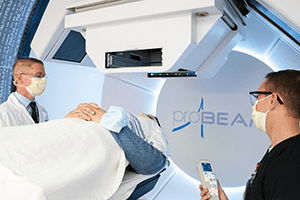Cincinnati Children’s/UC Health Center first to test new cancer therapy that takes less than 1 second
Cincinnati Children’s/UC Health Center first to test new cancer therapy that takes less than 1 second
Proton Therapy Center conducting clinical trial of ‘FLASH therapy’ in people
Thursday, November 19, 2020
The Cincinnati Children’s/UC Health Proton Therapy Center has begun the world’s first clinical trial of FLASH radiation therapy for cancer.
FLASH is a new mode of radiation therapy that can be delivered to a patient in as little as a single session that lasts less than 1 second, compared with traditional radiation therapy delivery of the same dose over minutes.
In preclinical testing, FLASH radiotherapy has been shown to potentially reduce side effects experienced with conventional radiation. However, until recently the technology to generate FLASH radiation for tumors inside the body did not exist for cancer patients.
Now, researchers at the Proton Therapy Center – in partnership with Varian Medical Systems, a provider of cancer care technologies and solutions – are using this new technology to study delivery of FLASH radiotherapy for human cancers.
The first study patient was treated this week. Up to 10 patients, whose metastatic cancer has spread to their bones, will participate in the research clinical trial of FLASH therapy.
Bone metastases are usually painful but respond to conventional radiation treatment. The clinical trial aims to determine whether equivalent results in pain relief can be achieved via FLASH therapy with similar or fewer side effects.
The Feasibility Study of FLASH Radiotherapy for the Treatment of Symptomatic Bone Metastases, also known as the FAST-01 study, is sponsored by Varian.
John C. Breneman, MD, medical director of the Proton Therapy Center on the Liberty Campus of Cincinnati Children’s, is principal investigator for the study. The Proton Therapy Center operates with funding and staffing provided by both Cincinnati Children’s and UC Health.
Advanced Technology
Before this first FLASH proton therapy trial involving people, researchers at the Proton Therapy Center led multiple studies testing the FLASH effect using mice and cell cultures.
To treat people using FLASH, Varian had to implement modifications to its standard equipment to enable the delivery of FLASH dose rates in a safe and controlled manner. In collaboration, the physicists at the Cincinnati Children’s/UC Health site, led by Anthony Mascia, PhD, commissioned this new technology for clinical use and developed the planning, quality assurance and treatment delivery methodologies required for a safe and effective treatment. The clinical trial required an Investigation Device Exemption from the U.S. Food and Drug Administration, which was obtained by Varian.
The Proton Therapy Center is one of the founding members of the FlashForwardTM Consortium, an international group of 20 institutions researching the use of proton beams delivered at ultra-high speeds to treat cancer. Additional work to show the safety of FLASH therapy in animals has been conducted in Europe and the United States by members of the consortium.
Targeting Other Cancers
Breneman noted that since this is the first in human trial of FLASH radiotherapy, it will build a foundation for extending this therapy to other types of cancer treatments.
“Trials using FLASH radiotherapy for other malignancies are currently being developed,” said Breneman, who also is a UC Health radiation oncologist and a professor emeritus at the University of Cincinnati College of Medicine. “Using FLASH treatment for these cancers could deliver higher cancer-killing doses without causing inordinate side effects, which would be a real advance.”
Additionally, FLASH therapy may require fewer treatments. So, instead of patients coming to a radiation therapy facility for six to eight weeks of daily radiation treatments, they may come for just one or two treatments of radiation exposure lasting less than 1 second each.
“FLASH is potentially a transformational advance for cancer treatment for many patients,” said John Perentesis, MD, director of the Division of Oncology & Cancer Programs at Cincinnati Children’s.
“If the side effects of radiation on the normal tissues surrounding a tumor can be significantly reduced, the dose of radiation to treat a cancer can be greatly increased,” Perentesis said. “This would raise hope to cure malignancies that respond to radiation but aren’t completely cured at current dose, including pediatric brain tumors like DIPG/pontine glioma and medulloblastoma, sarcomas, and neuroblastoma.”
International Center
The Proton Therapy Center, which opened in 2016, incorporates a $24 million, one-of-a-kind research facility. It includes a fully operational proton treatment room dedicated exclusively for research along with integrated laboratories.
Children and adults from around the world seek treatment for more than 30 types of cancer in two clinical therapy rooms at the local center. Patient care won’t be disrupted by the clinical trial.
A site for global research and development, the Proton Therapy Center is conducting leading-edge investigations in pediatric cancers, lymphoma, brain tumors, lung cancer, head and neck cancer, and other malignancies. Other clinical trials at the Proton Therapy Center are investigating the use of proton therapy in conjunction with new drugs to activate the immune system.
Contact Information
Barrett J. Brunsman
barrett.brunsman@cchmc.org




